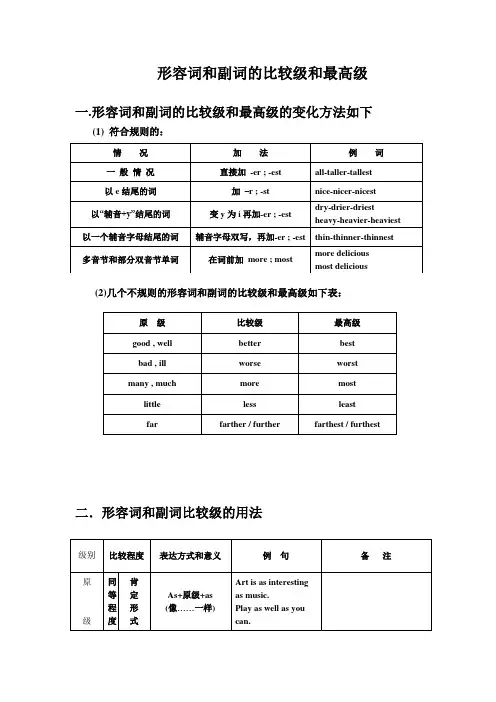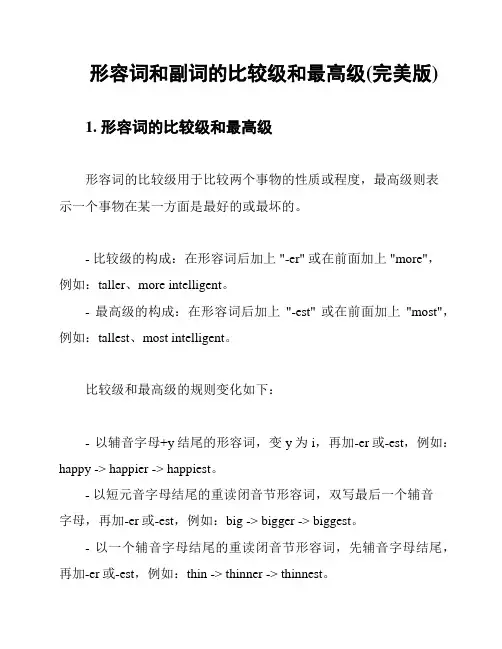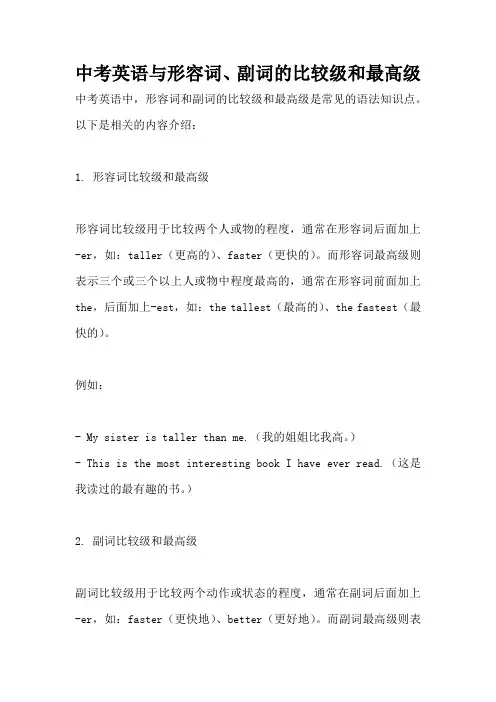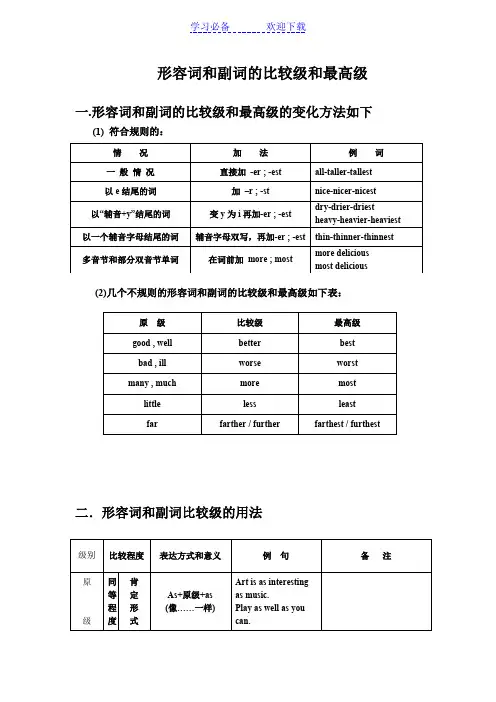初中英语形容词副词的比较级最高级大全
英语形容词和副词的比较级和最高级

形容词和副词的比较级和最高级一.形容词和副词的比较级和最高级的变化方法如下(1) 符合规则的:(2)几个不规则的形容词和副词的比较级和最高级如下表:二.形容词和副词比较级的用法注意:有些形容词,如 dead, empty, round, sure, woolen 等受本身含义的限制,没有比较级。
例题解析1. He is ________ friends than I.A. much moreB. many moreC. very moreD. too more解析:后面有可数名词复数时,many的比较级形式为many more 修饰。
应选B.2. Which is the _________ country, Japan or Australia?A. more developedB. more developingC. most developedD. most developing解析:两者比较用比较级,表示"发达"用developed, 而developing 是"发展中的" 意思3. There were _______ shops in the city in 1982 than in 1990.A. littleB. fewC. fewerD. less解析:little 不能修饰可数名词,两者比较需用比较级,所以应选C.4. If you are not free today, come another day __________.A. tooB. soC. insteadD. yet解析:instead 作副词用时意为"代替,顶替",表示前面的事情没做,而是做了后面的事。
Instead一般位于句首。
应选C.5.He can't tell us ________, I think.A. important anythingB. anything importantC. important somethingD. something important.解析:不定代词与形容词联用需后置,否定句中应该用anything而不是something. 因此应选B6. The Huang River is the second __________ river in our country.A. longB. longerC. longestD. the longest解析:"定冠词the+ 序数词+ 形容词最高级" 表示"第几大……" 应选C.7. The light in the office wasn't ________for him to read.A. enough brightB. bright enoughC. brightlyD. enough brightly解析:enough修饰名词时可前可后,修饰形容词或副词时,要后置。
英语中形容词副词的比较级和最高级

英语中形容词副词的比较级和最高级一般规律是:单音节词的比较级和最高级在词尾加 -er/-est;多音节词在前面加 more 或 most;双音节词如果是典型的形容词词尾,有明显的标示词类的功能,应保留词尾不变,在前面加 more 或 most。
其他的双音节词,两种变化都可以单音节词单音节的形容词,因为很短,适合在词尾变化(如: tall、taller、tallest)1、单音节词末尾加 -er 或 -esthigh 高的 | higher | highestslow 慢地 | slower | slowest2、单音节词末尾如果以 e 结尾,则加 -r 或 -stlate 晚的 | later | latestwide 广泛地 | wider | widest3、闭音节单音节词如末尾只有一个辅音字母,须先双写这个辅音字母,再加 -er 或 -estthin 瘦的 | thinner | thinnestfit 适合的 | fitter | fittest4、有些以 -y 结尾的单音节词, -y 前面是辅音时也可以直接加 -er 或 -estshy 害羞的 | shyer | shyestsly 狡猾的 | slyer | slyestwry 讽刺的 | wryer | wryest多音节词三个音节以上的多音节词已经很长,不适合再加词尾变化,因而在前面加 more 或 most,表示更(最)...,或者加 less 或least ,表示更(最)不...interesting 有趣的 | more interesting | most interestingimportant 重要的 | less important | least importantcarefully 认真地 | more carefully | most carefully双音节词双音节形容词很尴尬:不长不短,怎么判断?1、词尾是典型的形容词词尾,有明显的标示词类的功能,应保留词尾不变,在前面加 more 或 mostcrowded more crowded most crowdedloving more loving most lovinghelpful more helpful most helpfulfamous more famous most famousactive more active most active2、其他的双音节形容词,如果不是典型的形容词字尾,变化则无限制,两种变化都可以often oftener(more often) oftenest(most often)shallow shallower(more shallow) shallowest(most shallow)3、如果是 -y 结尾,这个长母音因为发音上的要求,要先变成短母音的 i,再加字尾变化,如:happy happier happiestlucky luckier luckiest二、不规则形式good/well | better | bestbad/ill/badly | worse | worstmany/much | more | mostlittle | less | leastfar | farther/further | farthest/furthestold | older/elder | oldest/eldest三、比较等级英语中形容词副词有三个比较等级,即原级、比较级和最高级1、原级(1) 表示程度相同,即“和...一样...”时用原级,常用"as... as" 结构It is as beautiful as paradise in Heaven. 这里如天堂般美丽This room is as broad as it is long. 那个房间长宽相等He is as handsome as John (is). 他和约翰一样英俊He studies as hard as John (does). 他和约翰一样努力(2) as...as... 引导的结构可采用倒装句型He studies as hard as John (does). = He studies as hard as does John.He is as handsome as John is. = He is as handsome as is John.(3) 否定的原级用 not as...as 或not so...as,二者区别不大You are not as tall as he. 你没有他高Guangzhou is not as clean as Shanghai. 广州没有上海那么干净I didn't do so well as I should. 我做得不如我应做得那么好(4) as/so... as... 结构前可以用 just、quite、almost、nearly、half 等词在程度上加以修饰This story was quite as interesting as we had thought. 这个故事和我们想的一样精彩The bike is not half so new as mine. 这辆自行车还没我的一半新She can read twice as fast as he does. 她的阅读速度比他快一倍John is not quite as good a student as his sister.连接词 as 表示这是组 as..as 的比较级。
形容词和副词的比较级和最高级(完美版)

形容词和副词的比较级和最高级(完美版)1. 形容词的比较级和最高级形容词的比较级用于比较两个事物的性质或程度,最高级则表示一个事物在某一方面是最好的或最坏的。
- 比较级的构成:在形容词后加上 "-er" 或在前面加上 "more",例如:taller、more intelligent。
- 最高级的构成:在形容词后加上"-est" 或在前面加上"most",例如:tallest、most intelligent。
比较级和最高级的规则变化如下:- 以辅音字母+y结尾的形容词,变y为i,再加-er或-est,例如:happy -> happier -> happiest。
- 以短元音字母结尾的重读闭音节形容词,双写最后一个辅音字母,再加-er或-est,例如:big -> bigger -> biggest。
- 以一个辅音字母结尾的重读闭音节形容词,先辅音字母结尾,再加-er或-est,例如:thin -> thinner -> thinnest。
- 多音节和部分双音节形容词前加more或most,例如:beautiful -> more beautiful -> most beautiful。
2. 副词的比较级和最高级副词的比较级和最高级的构成方式与形容词类似,只是在形容词的基础上加上 "-ly" 构成副词。
- 比较级的构成:在副词后加上 "-er" 或在前面加上 "more",例如:faster、more quickly。
- 最高级的构成:在副词后加上 "-est" 或在前面加上 "most",例如:fastest、most quickly。
与形容词类似,副词的规则变化也遵循相同的规律。
中考英语与形容词、副词的比较级和最高级

中考英语与形容词、副词的比较级和最高级中考英语中,形容词和副词的比较级和最高级是常见的语法知识点。
以下是相关的内容介绍:1. 形容词比较级和最高级形容词比较级用于比较两个人或物的程度,通常在形容词后面加上-er,如:taller(更高的)、faster(更快的)。
而形容词最高级则表示三个或三个以上人或物中程度最高的,通常在形容词前面加上the,后面加上-est,如:the tallest(最高的)、the fastest(最快的)。
例如:- My sister is taller than me.(我的姐姐比我高。
)- This is the most interesting book I have ever read.(这是我读过的最有趣的书。
)2. 副词比较级和最高级副词比较级用于比较两个动作或状态的程度,通常在副词后面加上-er,如:faster(更快地)、better(更好地)。
而副词最高级则表示三个或三个以上动作或状态中程度最高的,通常在副词前面加上the,后面加上-est,如:the fastest(最快地)、the best(最好地)。
例如:- She sings better than her sister.(她唱歌比她姐姐好。
)- He speaks English the most fluently in our class.(他在我们班上说英语说得最流利。
)需要注意的是,有些形容词和副词的比较级和最高级形式不规则,需要记忆。
例如:- good(好的)- better(更好的)- the best(最好的)- bad(坏的)- worse(更坏的)- the worst(最坏的)- well(好地)- better(更好地)- the best(最好地)- badly(坏地)- worse(更坏地)- the worst(最坏地)。
初中英语语法形容词和副词的比较级和最高级

形容词和副词的比较级和最高级一.形容词和副词的比较级和最高级的变化方法如下(1) 符合规则的:(2)几个不规则的形容词和副词的比较级和最高级如下表:二.形容词和副词比较级的用法注意:有些形容词,如 dead, empty, round, sure, woolen 等受本身含义的限制,没有比较级。
例题解析1. He is ________ friends than I.A. much moreB. many moreC. very moreD. too more解析:后面有可数名词复数时,many的比较级形式为many more 修饰。
应选B.2. Which is the _________ country, Japan or Australia?A. more developedB. more developingC. most developedD. most developing解析:两者比较用比较级,表示"发达"用developed, 而developing 是"发展中的" 意思3. There were _______ shops in the city in 1982 than in 1990.A. littleB. fewC. fewerD. less解析:little 不能修饰可数名词,两者比较需用比较级,所以应选C.4. If you are not free today, come another day __________.A. tooB. soC. insteadD. yet解析:instead 作副词用时意为"代替,顶替",表示前面的事情没做,而是做了后面的事。
Instead一般位于句首。
应选C.5.He can't tell us ________, I think.A. important anythingB. anything importantC. important somethingD. something important.解析:不定代词与形容词联用需后置,否定句中应该用anything而不是something. 因此应选B6. The Huang River is the second __________ river in our country.A. longB. longerC. longestD. the longest解析:"定冠词the+ 序数词+ 形容词最高级" 表示"第几大……" 应选C.7. The light in the office wasn't ________for him to read.A. enough brightB. bright enoughC. brightlyD. enough brightly解析:enough修饰名词时可前可后,修饰形容词或副词时,要后置。
形容词副词比较级最高级变化形式归纳(超全)

形容词/副词比较级最高级变化形式归纳大多数形容词和副词有比较级和最高级的变化,即原级、比较级和最高级,用来表示事物的等级差别原级即形容词的原形,比较级和最高级有规则变化和不规则变化两种。
规则变化:◇单音节以及少数双音节的词后面直接加-er , -est原级比较级最高级如:tall-taller-tallest◇以不发音的e结尾只加-r,-st◇“以辅音字母+y”结尾的词改y为i,再加-er, -est如:easy-easier-easiest pretty-prettier-prettiest◇以一个元音加一个辅音字母结尾的单音节词(即重读闭音节词),双写结尾的辅音字母er,-est 如:Thin-thinner-thinnest hot-hotter-hottest特别提醒:new, few, slow, clean等词含有字母组合,且发的是长元音,不用双写。
◇大部分双音节词和多音节的词(即音标中含有三个或三个以上元音音素的词),要在前面加more,most 如:beautiful -more beautiful-most beautiful特别提醒:以形容前缀un构成的三音节形容词不适合上述情况,如:unhappy-unhappier-unhappiest, untidy-untidier-untidiest◇以形容词+ly构成的副词要在前面加 more,most如:Slowly-more slowly-most slowly quickly-more quickly-most quickly特别提醒:early -earlier-earliest◇由ing分词和-ed分词演变过来的形容词(包括不规则动词如know→known)只能加more或most 来表示它们的比较级和最高级。
interesting-more interesting -most interesting excited-more excited -most excitingtired-more tired -most tired boring-more boring -most boring不规则变化原级比较级最高级good/well-better-best bad/badly/ill-worse-worstmany/much-more-most little-less-leastfar-farther/further -farthest/furthest old-older/elder-oldest/eldest特别提醒:◇further不仅可以指“距离更远”,还可指“程度更深”。
初中语法:形容词及副词的比较级、最高级
4、一般的形容词或副词的比较级前面可以加much/a little/even/still,而表示 数量的more之前还可以加some/any/no/one/two/many/several/a lot 等词。
如:It is much hotter today than yesterday. 今天比昨天热多了。 Would you like some more coffee? 你还要些咖啡吗? He did not eat any more. 他没有再吃。
5、more than /less than 分别可以理解为“多于/少于”,相当于 副词, more than = over; less than = under.
如:I lived in New Youk for more than four months. 我在纽约生活了四个多月。 6、“one of the +最高级+名词(复数)”整个短语为单数形式,谓语要用 单数形式。 如:One of the oldest house has been burned in a fire. 最古老的一幢房子在一场大火中被烧毁了。
※两者之 间没有差别时,使用句型:
主语(第一个人物)+谓语动词+as+形容词/副词原级+as+第二个人物
+...
如:He is as excited as his younger sister. 他和他妹妹一样兴奋。 ※ 表示第一个人比不上第二个人时,使用句型: 主语(第一个人物)+谓语动词(否定式)+as/so+形容词/副词原级 +as+第二个人物+... 如:He is not as/so excited as his younger sister. 他没他妹妹那么兴奋。
初中英语知识点归纳形容词和副词的比较级和最高级
初中英语知识点归纳形容词和副词的比较级和最高级形容词和副词的比较级和最高级是初中英语中非常重要的知识点。
通过掌握这些知识,我们可以更准确地描述人、事、物的特征和程度。
本文将归纳总结形容词和副词的比较级和最高级的用法和变化规则。
一、形容词比较级和最高级1. 形容词的比较级比较级常用于两个事物之间的比较,表示一方在某一方面的程度要超过另一方。
(1)一般情况下,在形容词后面加上-er构成比较级形式。
例如:- Tom is taller than Jerry.(汤姆比杰瑞高。
)- The book is cheaper than the movie.(这本书比这部电影便宜。
)(2)以字母e结尾的形容词,直接加-r。
例如:- Kate is braver than her sister.(凯特比她妹妹更勇敢。
)(3)以辅音字母+y结尾的形容词,先把y变成i,再加-er。
例如:- This shirt is prettier than that one.(这件衬衫比那件更漂亮。
)(4)部分双音节和多音节形容词在前面加上more来构成比较级形式。
例如:- He is more intelligent than his classmates.(他比他的同学们更聪明。
)2. 形容词的最高级最高级用于三个或三个以上的事物之间的比较,表示一方在某一方面的程度是所有事物中最高的。
(1)在形容词后面加上-est构成最高级形式。
例如:- Alice is the tallest girl in the class.(艾丽斯是班上最高的女孩。
)- This is the cheapest phone I've ever seen.(这是我见过的最便宜的手机。
)(2)以字母e结尾的形容词,直接加-st。
例如:- It is the largest lake in the city.(这是城市里最大的湖。
)(3)以辅音字母+y结尾的形容词,先把y变成i,再加-est。
初中形容词和副词的比较级最高级
初中形容词和副词的比较级最高级形容词和副词的比较级和最高级变化方法如下:1) 符合规则的:一般情况:直接加-er和-est。
以e结尾的词:直接加-r和-st。
以“辅音+y”结尾的词:变y为i再加-er和-est。
以一个辅音字母结尾的词:辅音字母双写,再加-er和-est。
例词:all-taller-tallest。
nice-nicer-nicest。
dry-drier-driest。
heavy-heavier-heaviest。
XXX-XXX-thinnest。
多音节和部分双音节单词在词前加more和most,如more us。
2) 几个不规则的形容词和副词的比较级和最高级如下表:原级:good。
well。
bad。
ill。
many。
much。
little。
far比较级:better。
worse。
more。
less。
XXX最高级:XXX。
worst。
most。
least。
XXX形容词和副词比较级的用法:级别表达方式和意义例句原级 As+原级+as(像……一样) XXX。
不如……那样) She does not study so well as I do。
比较级比较级+than(比……) XXX XXX。
比较级前面可以加much。
far。
even。
still。
a lot。
a little。
a bit等。
I like pork better than beef。
程度加深比较级+and+比较级(越来越……) XXX。
The +比较级,the +比较级(越……,越……) XXX.The more books she reads。
the better her XXX the best season of the year。
Lin Tao jumped the farthest of all。
Note that the article "the" is often omitted before the XXX。
形容词与副词的比较级和最高级
形容词与副词的比较级和最高级
形容词和副词在比较级和最高级方面有不同的形式。
下面是它们的比较级和最高级形式的规则:
1. 单音节词或少数双音节词的比较级和最高级:
- 比较级:在形容词或副词前加上 "-er"。
- 最高级:在形容词或副词前加上 "-est"。
例如:
- 比较级:big(大)→ bigger(更大)
- 最高级:big(大)→ biggest(最大)
2. 以字母 "e" 结尾的单音节词或少数双音节词的比较级和最高级:
- 比较级:在形容词或副词前加上 "-r"。
- 最高级:在形容词或副词前加上 "-st"。
例如:
- 比较级:nice(好)→ nicer(更好)
- 最高级:nice(好)→ nicest(最好)
3. 多音节词和部分双音节词的比较级和最高级:
- 比较级:在形容词或副词前加上 "more"。
- 最高级:在形容词或副词前加上 "most"。
例如:
- 比较级:beautiful(美丽的)→ more beautiful(更美丽的)
- 最高级:beautiful(美丽的)→ most beautiful(最美丽的)
需要注意的是,有一些形容词和副词的比较级和最高级形式是不规则的,需要
单独记忆。
例如:
- good(好)→ better(更好)→ best(最好)
- bad(坏)→ worse(更坏)→ worst(最坏)
希望以上解答对你有所帮助。
如果你有其他问题,请随时提问。
- 1、下载文档前请自行甄别文档内容的完整性,平台不提供额外的编辑、内容补充、找答案等附加服务。
- 2、"仅部分预览"的文档,不可在线预览部分如存在完整性等问题,可反馈申请退款(可完整预览的文档不适用该条件!)。
- 3、如文档侵犯您的权益,请联系客服反馈,我们会尽快为您处理(人工客服工作时间:9:00-18:30)。
easy happy healthy early busy ugly curly funny scary pretty angry cloudy sunny rainy windy lovely friendly unfriendlyunhappy unlucky furry tiny guilty greedyheavy moody lively thirsty lazy hungry sorry empty crazy silly pushy lucky shy(2种)
形容词、副词的比较级和最高级
1、一般单音节词和“er, ow, y, le”结尾的双音节词+er, est。
hard quick cold newsourround smart loud mean stupid wild dull quiet black warm sick bright cool near weak bald young straight tall short long calm deep cheap strong high slow dark great blind dumb deaf full poor realfew grayoften(2) stupid(2)polite(2种)clever narrowsimple
crowded
new
sour
warm
sick
bright
cool
near
free
close
nice
able
white
sore
true
large
handsome
careless
careful
carefully
quickly
quietly
disappointed
friendly
unfriendly
unhappy
stupid
wild
much
little
far
late
old
successful
unpleasant
similar
pleasant
polite
common
good
well
bad
ill
many
quiet
deaf
full
poor
real
gray
often
clever
narrow
simple
fine
true
2、e结尾的+r, st
fine free close nice ablandsome lame true sure cute(2种)
3、单元音+1个辅音双写词尾+er, est
red big hot thin fat sad slim flat mad
原级
比较级
最高级
词义
good/well
better
best
bad/ill
worse
worst
many/much
more
most
little
less
least
far
farther
farthest
距离
further
furthest
程度
late
later
latest
时间(迟到)
latter
last
顺序(先来后到的关系)
old
older
oldest
年龄关系
elder
eldest
兄弟姐妹关系
形容词、副词的比较级和最高级的考试
原形比较级最高级
hard
quick
cold
nervous
unusual
usual
modest
natural
realistic
popular
loving
inexpensive
comfortable
convenient
beautifully
interested
famous
expensive
inexpensive
tired
delicious
open
difficult
dark
early
busy
ugly
curly
funny
scary
pretty
angry
cloudy
sunny
lovely
empty
hungry
原形比较级最高级
cute
red
hot
fat
slim
mad
easy
happy
healthy
amazing
awful
exciting
excited
lazy
不
规
则
变
化
多数
多音节词
more,most
+原级
useful famous quickly beautiful creative serious outgoing amazing awful exciting excited interested famous expensive inexpensive tired(双元音)real(双元音)honest wonderful interesting fantastictruly(双音节副词)sadly(双音节副词)slowly(双音节副词)deeply(双音节副词)beautifully delicious open(opener开启工具)difficult carefully beautifully careless active athletic foolish wrong(单音节词)right(单音节词)casual casually nervous unusual usual modest natural pleased realisticpopular loving inexpensive comfortable convenient crowded careless careful carefully completely quickly quietly specifically disappointed successful suitable educationalunpleasant similar pleasantcommon(2种)gradually disgusted aggressive particularly enormousintelligent originalembarrassed convincingexhausted(斜体不考)
unlucky
tiny
heavy
lively
原形比较级最高级
carefully
beautifully
active
wrong
right
round
smart
loud
short
long
calm
cheap
strong
high
real
honest
wonderful
interesting
sadly
slowly
deeply
